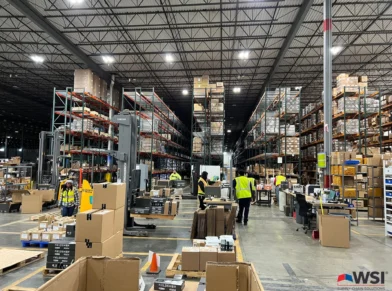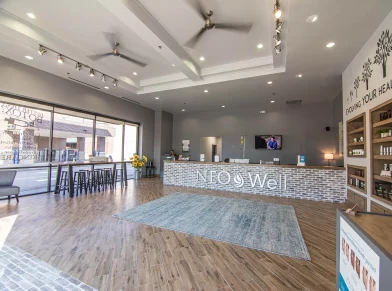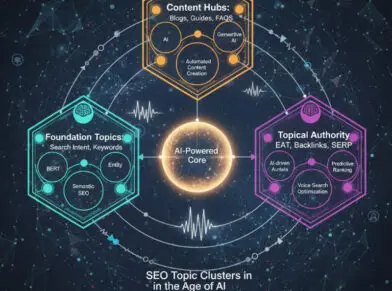The Ultimate Guide to Link Building for Marketing Success
What is Link Building?
In its most basic form, link building is the process of acquiring hyperlinks from other websites to your own.
It’s considered to be one of the key pillars of SEO success, a fact that Google’s Andrey Lipattsev himself confirmed in a web seminar. The Search Quality Senior Strategist at Google revealed that links, content, and RankBrain are the top three ranking signals in Google’s search algorithm.
But, that’s not all there is to link building. You see, links are like the digital version of word-of-mouth marketing. Building them not only boosts your SEO, but also spreads brand awareness, attracts referral traffic, and establishes industry credibility.
Make no mistake about it, though. Link building is not as simple as scattering hyperlink breadcrumbs across the web. The most impactful links are those that are relevant, high-quality, and organically integrated. Such links are not forcibly embedded or purchased – rather, they’re earned based on the value of your content and the relationships you’ve nurtured.
This guide explains exactly how you can achieve these valuable links. Read on to discover the best SEO linking strategies to include in your digital marketing plan, the benefits they bring to your marketing efforts, plus the common mistakes to avoid.
And to help you make sense of it all, let’s start with the basics of link building. This is where we go into the detail of what is link building, and the role that quality link building plays in SEO.
Understanding the Basics of Link Building
Links come in two principal flavors – internal and external.
Internal links are the ones that connect pages within the same domain. Their job is to help visitors navigate your website. They direct them from one piece of content to another in a logical and intuitive way.
External links, on the other hand, connect other domains to your website. They’re otherwise known as backlinks or incoming links, and their role is to point out references. Whenever a website publishes your backlink, they’re basically identifying your website as the go-to authority on the subject matter.
Search engines like Google view these backlinks as votes of confidence. They interpret each as a sign that the link destination page has been vetted and qualified as a credible reference. It’s a bit like being the popular kid in school. The more people like you (or in this case, link to you), the more visibility and recognition you get.
Link Signals and How They Influence SEO
In the context of SEO, link building is not about who can make the most moves, but rather who can execute each move with precision and grace. Each backlink you acquire sends a distinct set of signals to search engines. The signals are then evaluated separately, and the SEO weight of each backlink is ultimately calculated based on a range of factors.
Search engine algorithms typically consider factors such as:
- Link Quantity: Search engines calculate the number of links pointing to a website and then interpret the total volume as an indication of its popularity and trustworthiness. Building more links may therefore have a positive influence on your SEO.
- Link Quality: The quality of the backlink matters just as much, if not more, than the quantity. Quality links are identified by evaluating the history of the linking domain, the relevance of the linking page, and the credibility of the linking source. High-quality links from authoritative and contextually-related websites are the ones that pack the strongest SEO punch.
- Anchor Text: Anchor text, which is the clickable text in a hyperlink, helps search engines understand the context of the destination page. But, while optimizing anchor text with relevant keywords can boost the SEO value of the target page, overdoing it may raise red flags.
- Link Diversity: A diverse link profile – with links coming from varied domains, IP addresses, and website types – is a boon for SEO. It represents a natural link-building pattern, thus minimizing the risk of being marked for shady “black hat” link-building tactics.
To improve search engine rankings you want links that are:
- High-quality, relevant, and natural.
- Anchored to contextual keywords.
- Diverse.
- Plentiful.
Types of Links: Natural, Manual, and Self-Created
Now that you can answer the question “what is link building?” let’s review the three types of links you can pursue:
- Natural Links: These are the backlinks you earn from other websites without any direct solicitation. You can build them by creating authoritative content that’s worth linking to.
- Manual Links: These are the links you actively seek out through outreach efforts. You could, for instance, collaborate with industry bloggers, influencers, or journalists on link exchange programs.
- Self-Created Links: Also known as non-editorial links, self-created links are built by website owners in an attempt to trick search engines. They are often integrated into blog comments, press releases, guest posts, advertorials, and infographics.
Benefits of Link Building for Marketing
Whereas link building is often associated with SEO, it’s one of those digital marketing strategies that have multiple benefits. Here are some of the positive impacts link building has on a website:
#1. Improves Organic Search Rankings
Securing quality backlinks from authoritative websites is like getting a vote of confidence in your industry. Search engines interpret such links as indicators of your site’s credibility and relevance, thereby elevating your organic search rankings.
Through this entire journey, anchor text provides search engines with context about your page. You can thus optimize hyperlinks with relevant keywords to enhance the SEO value of your page.
#2. Increases Website Traffic and Referrals
Once you’ve published a permanent backlink on an authoritative site, you stand to attract a steady stream of referral traffic. And unlike traditional advertising campaigns that cease to generate traffic once they end, high-quality backlinks can maintain a continuous flow of traffic from external sources.
Other than that, link building can drastically boost website visibility and exposure. As your site rises in search engine rankings, it pulls in more potential customers – translating to increased sales and revenue.
#3. Reinforces Brand Authority and Credibility
Google is not the only entity that recognizes endorsements from quality SEO linking. The links influence others as well.
Whenever they come across your backlinks on authoritative platforms, web visitors begin to associate your brand with trustworthiness and reliability. This positive perception may then accelerate your engagement, conversions, and customer loyalty – further cementing your brand’s market dominance.
#4. Expands Online Visibility and Reach
Link building can also significantly amplify your brand’s online visibility and reach.
It turns out that the more your site is linked to on other sites, the more likely you are to attract additional links and traffic. This has a cascading effect, where increased visibility triggers even more page views, which can lead to exponential business growth.
The same link-building has the potential to generate opportunities for guest blogging, speaking engagements, or media coverage – all of which you could leverage for additional online visibility. Then if you manage to get your links published by websites that have a strong social media presence, your content will be shared widely with a large audience.
#5. Grows Conversions and Sales
As quality SEO linking propels your site higher in the search results, it’s expected to attract more potential customers – which should ultimately translate to increased sales and revenue.
You’ll also be seeing more conversions coming your way by virtue of being a leader in your industry. Customers find it easy to trust authoritative brands, a position that you’ll get through sustained link building.
Strategies and Techniques for Effective Link Building
Over the past two decades, link building has transitioned from an anything goes proposition to a methodology focused on earning links via high-quality content and strategic outreach.
This drastic shift has made the process of link building a bit more challenging. But then again, its exclusivity has turned it into an even more powerful tool for enhancing your website’s visibility, credibility, and organic reach. You just need to set yourself apart with the right strategies and techniques, explored below.
Creating High-Quality, Relevant Content
What is link building without content?
The cornerstone of any successful link building strategy is high-quality content. This is the bait that lures other websites and convinces them to link to your own. And to be specific, the biggest magnets for backlinks are those exceptionally insightful content pieces that are well-researched, highly engaging, and full of unique perspectives.
Such content usually resonates with the interests and necessities of the target audience. It addresses their concerns, proposes relevant solutions, and provides authentic value.
To discover the best content opportunities in your industry, you could bring in tools like Google Keyword Planner, SEMrush, or Moz Keyword Explorer. They’ll reveal keywords that have a strong search volume but present low competition.
Then when it comes to writing, we’d advise you to conduct in-depth research on your chosen subject while verifying the accuracy of the insights. All your arguments should further be supported by credible sources, statistics, and examples.
You might also want to incorporate well-structured headings, bullet points, and paragraphs for the sake of readability. Then to attract even more engagement, consider complementing the text with multimedia elements such as images, infographics, videos, or charts.
When the content piece finally goes live, remember to promote it extensively for increased visibility. The more people it reaches, the more likely you are to attract natural links. So, you can go ahead and engage audiences through social media, email marketing, and content syndication, or maybe reach out to influencers, bloggers, and media publishers in your niche.
Leveraging Guest Blogging and Influencer Outreach
Guest blogging and influencer outreach are two other powerful strategies for link building.
Guest blogging, for starters, entails creating and publishing content on other websites within your industry or niche. You could thus incorporate your backlinks into the text or author’s bio, and then get the articles published on authoritative websites for optimum gains in link juice.
Influencer outreach, on the other hand, tries to foster relationships with industry influencers, in the hope that partnering with them will earn you backlinks and increase brand visibility.
If you choose to give it a try, your best growth chances would be with celebrated influencers who command a highly dedicated and engaged following. You could then get them to promote your stuff through sponsored content, reviews, or interviews. All the endorsements from such influencers will serve as social proof for your brand, potentially leading to improved visibility and organic backlinks.
In both guest blogging and influencer outreach, you should try to partner with authoritative entities that resonate with your target audience. So, take the time to investigate your options by their online presence, content quality, engagement rates, and audience demographics. Tools like Ahrefs, Moz, BuzzSumo, or NinjaOutreach can help.
Building Relationships and Networking
If you manage to establish genuine connections with website owners, bloggers, influencers, and industry professionals, they’ll provide you with valuable opportunities for backlinks, guest blogging, and collaborative content creation.
These relationships are not just for the short term. By continually providing value and nurturing the connections, you could maintain all those link building partnerships for the long haul.
The networks will even support you with content amplification. You could request them to share and promote your publications among their audiences – thereby sparking more visibility, organic backlinks, and social media engagement.
To build such relationships, start by identifying thought leaders in areas that complement your specialties. You could even use social media platforms, industry forums, conferences, and tools like BuzzSumo or NinjaOutreach to discover them.
Once you’ve identified potential contacts, use a calculated approach to get noticed and build rapport. Engage with them on social media platforms, leave thoughtful comments on their blog posts, share their content, and engage in meaningful conversations.
Remember, the key to building relationships is providing value. So, to capture authoritative prospects, you should always find mutually beneficial ways of collaborating.
Utilizing Social Media for Link Building
Social media platforms, with their multi-billion active users, present a vast avenue for expanding your link-building reach and content visibility.
You’ll find opportunities for fostering relationships and networking with industry professionals, influencers, and potential link partners. You can also leverage content amplification to boost discoverability and potentially attract natural backlinks from a wide audience.
Now, to exploit social media for link building, begin by crafting high-quality, share-worthy content on your website. You can embed social sharing buttons on your website, as well as incorporate CTAs into your blog posts to motivate readers to share the content. The featured post layout itself should be designed in a manner that teases audiences with visually captivating content snippets.
Earning Links through Public Relations and Press Releases
Use press releases to broadcast your brand’s noteworthy events, product launches, industry insights, or significant achievements. The idea here is to get the attention of news outlets and industry publications, in the hope that they’ll feature your story in the media. Every single time you’re published is basically an opportunity to boost your brand’s credibility and build high DA backlinks.
By regularly sharing valuable and newsworthy information, your brand will progressively increase its odds of getting published. Your ever-growing presence could even pique the interest of journalists, bloggers, and influencers – who might then start to treat your brand as a reliable source of industry news.
Do some research and generate a list of newsworthy items about your brand and industry including events, milestones, product introductions, and industry revelations, etc. Next, find the best publishers to share them with. Find journalists, bloggers, and influencers who specialize in your industry. You’ll need someone with a large online presence, a highly engaged audience, and content that complements your published topics.
Link Building Best Practices and Tips
Conduct Competitor Backlink Analysis
An analysis of your competitors’ backlinks may yield invaluable insights into their link building strategies – including link patterns, anchor text distribution, and the types of websites they target for backlinks.
Such info can be a springboard for enhancing your own link building strategy. You might, for instance, discover types of content or topics that they’ve garnered backlinks from, identify content gaps, uncover unique perspectives, or brainstorm ways to refine publications on your website.
You’ll find the data in the backlink analysis sections of SEO research tool suites like Ahrefs, SEMrush, Moz, or Majestic.
Avoid Black Hat Link Building Techniques
Although the prospect of quick wins may appear attractive, resorting to black hat techniques exposes your website to all sorts of penalties – which may ultimately lead to a drop in rankings, diminished visibility, or even removal from search engine results.
Bouncing back from such penalties is anything but easy. And that’s if you even manage to recover in the first place.
Some of the most common black hat stumbling blocks that you might want to avoid include:
- Link Farms: Link farms are networks of thin websites that have been built exclusively to host tons of low-quality links.
- Paid Links: According to Google, paid links are those backlinks procured from third-party websites or link networks. Payment could be in monetary form or incentives.
- Private Blog Networks (PBNs): PBNs are networks of websites that exist solely to contribute backlinks to a central destination site.
Balance Between Do-Follow and No-Follow Links
To remain on the good side of search engines, you need to carefully engineer your backlink profile to appear 100% organic. You can start by building a diverse portfolio of both Do-Follow and No-Follow links.
Do-follow links are the standard backlinks that search engines acknowledge and follow. carry “link juice” from the referring web page to the linked page, thereby influencing search engine rankings and domain authority.
No-follow links are the direct opposite of that. Designated with the rel=”nofollow” attribute, they instruct search engines not to transfer link equity. This is what you should use on user-generated content, sponsored links, affiliate links, and so forth.
A healthy mix of do-follow and no-follow links suggests to search engines that your website is acquiring backlinks naturally, rather than resorting to manipulative tactics.
Measure Your Link Building Success
Link building, like any other marketing strategy, should be quantified and monitored consistently. The analytics will help you objectively measure performance, discern the strengths and weaknesses in your tactics, as well as refine your approach over time.
The best time to work out the specifics is before the actual campaign. You should come up with clear goals, and then use that to define the KPIs to track. The objectives could range from increasing organic search traffic, improving search engine rankings, and driving referral traffic, to enhancing brand visibility.
Tools like Majestic, Ahrefs, or Moz are your compass in that journey. They offer detailed backlink analytics, with which you can monitor the quantity, quality, and diversity of your backlink profile. Some of their key metrics include domain authority, page authority, anchor text distribution, and the number of referring domains.
But remember, acquiring backlinks is not the end goal in link building. You should try to measure even the impact of those links. The likes of SEMrush, Moz, and Ahrefs already have a rank-tracking feature for that.
Google Search Console can otherwise offer invaluable data on the number of clicks, impressions, and click-through rates (CTRs) from your backlinks. You could then adjust your strategy to focus on sources that drive meaningful traffic.
Common Link Building Mistakes to Avoid
As you undertake link building efforts, avoid these common mistakes:
Over-Emphasizing Quantity over Quality
One common misconception is that more is always better. Its proponents try to acquire as many links as possible, with little regard for their quality or relevance.
This approach has, however, been proven to be counterproductive – as it could potentially damage your website’s search engine rankings and overall reputation. The likes of Google nowadays pay more attention to quality indicators such as the authority of the linking site, the context of the link within the content, and link profile authenticity.
Ignoring Relevance and Context of Links
Another common pitfall is neglecting the relevance and context of the links you acquire. Ideally, your backlinks should come from websites that are pertinent to your industry or topic. A lack of relevance could otherwise dilute the value of the link and potentially undermine your SEO efforts.
You can gauge relevance by examining the content surrounding the link, the anchor text used, and the overall topical alignment between the linking and target sites.
Relying Solely on Link Directories
Link directories, once a popular method for link building, have fallen out of favor due to their susceptibility to manipulation. Google’s Penguin algorithm update, for instance, penalizes websites that rely heavily on low-quality directories for link building.
Instead of putting all your eggs in the directory basket, diversify your approach. Focus on acquiring links from authoritative and relevant websites through outreach, content marketing, and relationship building. This strategy is more likely to produce sustainable, long-term benefits.
Neglecting the Importance of Internal Linking
It’s understandable to prioritize backlinks in link building efforts – but not at the cost of internal links.
When inbound links pull in the link juice, you’ll need internal links to pass on the flow of link equity and authority to other pages on your website. The same internal links guide web visitors to related content, while search engines rely on them to interpret the site’s structure and hierarchy.
Failing to Update and Maintain Existing Links
Links, like any other website asset, links require regular maintenance and updates. And that’s because URLs could change over time, pages may be restructured, or content edited. Some of these adjustments lead to broken or outdated links, which may then compromise SEO performance and user experience.
You should thus audit your links from time to time to confirm that they’re up to date. Tools like Ahrefs will even flag up your broken backlinks, upon which you could reach out to the affected publishers with an update request.
What is Link Building to You?
Based on everything we’ve covered, it’s now confirmed that the traditional one-sentence definition of link building doesn’t fully capture its essence. This is what you should say instead if you’re ever asked “what is link building?”
- It’s a competitive edge: While many websites engage in link building, those that do it effectively gain a significant advantage in the increasingly competitive digital landscape.
- It drives organic growth: As your link profile expands, so does your organic traffic. Each new link is a pathway for web users to discover your website, convert faster, and buy more.
- It’s a strategy for long-term success: Unlike some digital marketing tactics that offer quick but fleeting results, link building is a strategy designed for long-term success. The benefits of a well-executed link building campaign can last as long as the links themselves.
- It’s a relationship builder: You get to build long-term relationships with other websites and influencers, which then facilitate increased collaboration.
- It generates exponential success: The few who achieve success in link building get to experience a cascading effect of more success. The wider your link profile expands, the more prominent your brand grows – thereby attracting even more backlinks.
- It’s a continuous journey: Link building isn’t a one-time task but an ongoing process. As your website evolves and grows, so too should your link building efforts.
To you, link building is more than just a tactic for improving search engine rankings. This is a far-reaching strategy that can positively impact nearly every aspect of your digital presence.
With those numerous benefits, however, comes just as many demanding conditions. Link building has evolved into a sophisticated marketing strategy that requires calculated tactics, data-driven decisions, interpersonal interactions, and finesse in working around search engine algorithms.
You could try your luck with these strategies, but as you can see, link building is complex and multi-layered. If you don’t have the time or the inclination to undertake your own link-building campaign, you could simply partner with a dynamic digital marketing agency that understands all the nooks and crannies of link building.
Don’t let link-building inexperience or intimidation hold you back from the huge traffic and lead gains you could realize. Contact Globe Runner today for a no-obligation quote on link-building or our full suite of SEO services.
Are you ready for GA4?
Just when we had all gotten comfortable using Universal Analytics, Google Analytics 4 (GA4) was brought in to replace it. The switch itself is happening in three phases:
- It began on October 14, 2020, when GA4 displaced Universal Analytics as the default platform on the Google Analytics website.
- The next milestone will be on July 1, 2023, when the new Google Analytics 4 will permanently cease supporting Universal Analytics properties.
- The sunset for Universal Analytics 360 will then follow a year later on July 1, 2024.
This is no ordinary “system upgrade”, though. Google Analytics 4 is, rather, a complete overhaul of the previous generation of Analytics. It has changed the entire data tracking ecosystem, forcing Universal Analytics users to retrain themselves on leveraging the platform. They now have a ton more data and customization options to work with, which in turn makes the learning curve even steeper.
That has, understandably, elicited mixed reactions from the business community. On the whole, however, the users of Google Analytics 4 are seeing positive results from the renewed digital analytics. Key Performance Indicators (KPIs) from the platform are turning out to be exceedingly transformative to websites and apps.
All that power is yours for the taking, as GA4 itself is completely free of charge. This guide will even provide you with the headstart needed to get it underway. By the time you’re done reading it, you’ll have understood not just the full potential of Google Analytics 4, but also how to set it up on your website or app.
What is Google Analytics 4?

Google Analytics 4, or GA4 in short, is the latest version of Google’s web analytics platform. And while previous generations provided data analytics for websites, GA4 is engineered to track both web and app properties.
The tracking system here is not built on the same technologies as its predecessors. Google Analytics 4, instead, rides on a user-centric ecosystem that follows customers through their entire journey. You get to monitor not just your traffic metrics, but also the corresponding customer usage analytics.
Google has also future-proofed GA4 by aligning its data tracking with the latest privacy laws, including CCPA and GDPR. Third-party cookies and identifiers have been replaced by first-party trackers, which only monitor user behavior and keep the users anonymous. Any arising data gaps are then filled by predictive analytics from sophisticated machine learning and statistical models.
Setting up Google Analytics 4 for Your Website or App
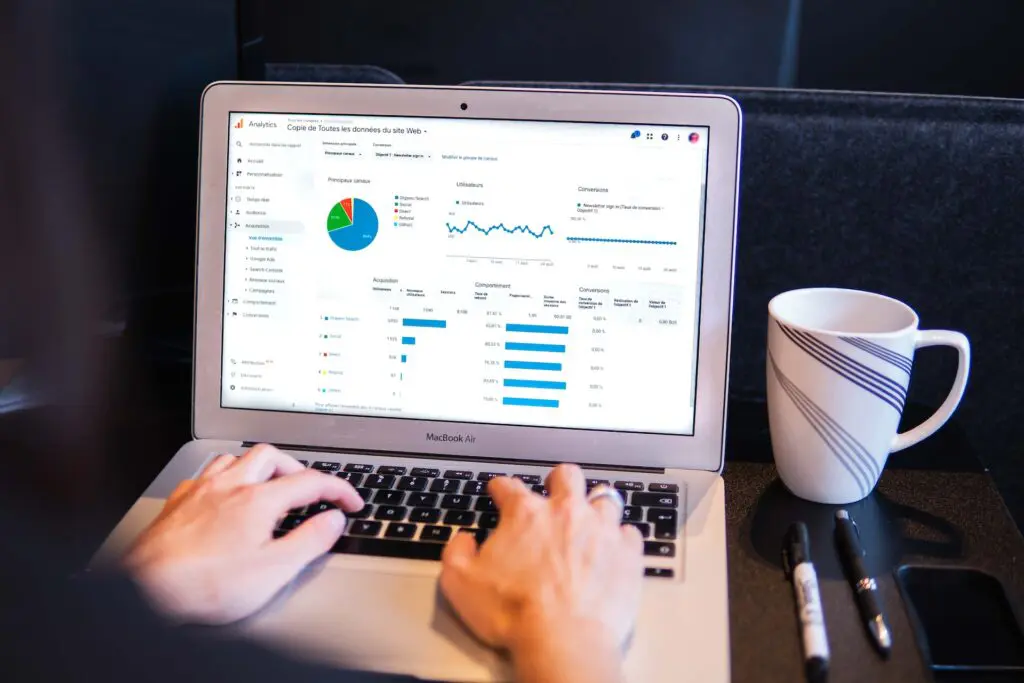
Your GA4 setup options depend on the strategy that you’re currently running on Google’s Analytics platforms.
If, for instance, your properties were added to the Google Analytics platform after October 14, 2020, you don’t need to take any additional steps. You’re already set, as GA4 has been the default solution all along.
The exemption doesn’t extend to any properties configured before that October 2020 D-Day. Universal Analytics was the default option back then, and you can even confirm it for yourself by checking your property’s ID. If the number begins with “UA”, it means the property was built on Universal Analytics and is due for GA4 migration.
In that case, you might want to create a new one on Google Analytics 4 and then link it with your existing Universal Analytics asset. The setup process itself is as follows:
- Go to analytics.google.com and log into your Google account.
- Once you’ve landed on the dashboard, proceed to the left navigation panel and click on Admin. This will take you to your admin settings.
- Under the Admin tab, you’ll see two sections – Account and Property. Go to the Property section and hit the Create Property button positioned at the top.
- Google will subsequently display a series of property setup prompts, which you should follow to add a new property to the account.
- After the property has been added, GA4 will list it in the Property column of the Admin Settings page. You can then click on the Setup Assistant to launch the setup wizard.
- It’s on that Setup Assistant wizard where you get to connect your new Google Analytics 4 deployment with your website or app. The button at the top links your GA4 property with its pre-existing Universal Analytics equivalent, the Data Collection subsection configures Google Analytics 4 into your website, while Property Settings offers controls for defining audience segments and KPIs.
Understanding Key Features of Google Analytics 4
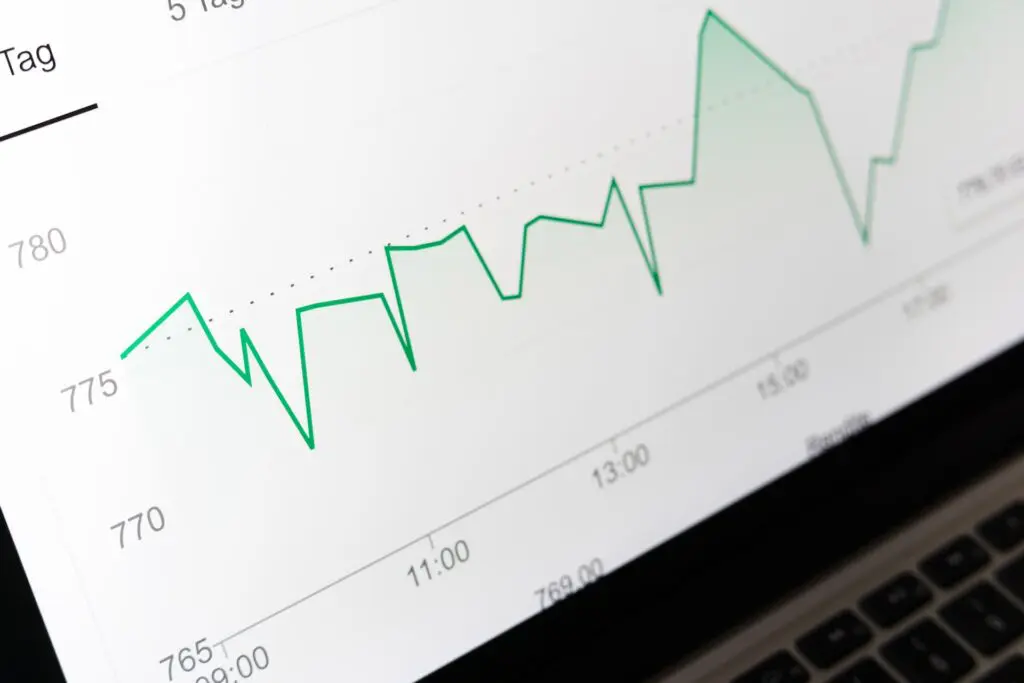
Google Analytics 4 is essentially a blend of privacy-centric tracking, cross-channel data metrics, and AI-driven predictive analytics. This is what ultimately generates in-depth insights into your customers’ journeys – from the moment they land on your website, through all their touchpoints, to the actions they might take in the future.
Universal Analytics had some pretty decent analytics too. But, it only offered generalized traffic data, with page views being the primary Key Performance Indicator (KPI). Google Analytics 4, on the other hand, goes beyond the page views to highlight individual audience interactions. You should be able to generate reports on engagement time, engagement rate, engagement sessions, etc.
Another thing that GA4 saves you is the trouble of piecing together measurements from Google Analytics for Firebase, Firebase Analytics, and Google Analytics for Apps. You no longer have to combine different data analytics tools to monitor multiple devices. Everything is now available on one centralized interface, courtesy of GA4’s cross-device tracking.
What it logs as user behavior is progressively fed into its underlying machine-learning engine, which then uses artificial intelligence and statistical models to make predictions about future events. It’s from these reports that you get to find out your revenue forecast, churn probability, purchase probability, etc.
As for the properties, Google Analytics 4 is flexible enough to accommodate both apps and web-based assets. You can set it to track up to 2,000 properties at once. The limit on the number of source properties is 50, each of which can be broken down into 400 sub-properties.
Using Google Analytics 4 for Website & App Tracking
GA4 is your go-to all-in-one digital analytics solution when you need to quantify user interactions on your website or app. It can track both website and app properties separately or as continuous experiences. Then from the analytics, you should be able to figure out not just the traffic volume streaming in, but also how users are engaging with your websites and apps.
All the interactions are measured as events. And they could be any type of user activity – from opening a web page, opting into a mailing list, or completing a purchase, to watching an in-app ad, running an app feature, or opening app messages.
You could also use Google Analytics 4 to track events executed by the website or app. This is where you measure occurrences like app crashes, form displays, page redirects, etc.
Overall, you’ll be tracking four types of events on your GA4 account:
- Automatically collected events: These are the events that are measured by default when you add your website or app property to Google Analytics 4. Examples include app updates, in-app purchases, app sessions, and page visits.
- Enhanced measurement events: These are the events that are tracked when you proceed to enable the enhanced measurement option. They include form interactions, file downloads, video engagement, site search, outbound clicks, page scrolls, and page views.
- Recommended events: While the previous two categories are default options, recommended events are set up manually from a list of predefined references.
- Custom events: Custom events are configured entirely from scratch. But, you’ll need custom coding skills to proceed.
Google Analytics 4 further allows you to mark specific events as conversions. And they don’t have to be sales instances – any important occurrence to your business should do.
Each user’s interactions are eventually linked to form a continuous user experience funnel. You’ll be able to view all the touchpoints and engagements that individual buyers sailed through before converting. This includes the actions taken on both your website and app properties.
To understand the users even better, you might want to separate them into segments. GA4 facilitates this by allowing you to define the audience conditions for each segment. You could, for instance, have a segment for users who’ve only interacted with your app, another one for PC-based visitors, plus maybe separate categories for first-time and returning customers.
Using Google Analytics 4 for Online Marketing

Now that third-party cookies are practically dead, Google Analytics 4 couldn’t have come at a better time. Cookie rejection rates have already reached 64% and still rising, yet marketers need them more than ever to cater to the growing demand for personalized experiences.
GA4 has found a way around the problem, allowing marketers to track audiences without violating any data privacy laws. Instead of identifying users by their IP addresses, the platform uses privacy-centric approaches such as IP anonymization. ID values here are in the form of randomly generated strings that are linked to users’ browsers and devices.
Otherwise, when the user ID is unavailable, the system relies on user info from Google signals. And in the rare occasions that the two identifiers are both missing, Google Analytics 4 turns to AI-driven statistical modeling. It basically uses machine learning to predict the attributes of an unidentified user based on the behaviors of similar users.
The predictive analytics go on to enrich the user data you’ve been collecting from events, and the result is usually accurately-segmented audiences. This is what you ultimately leverage in your targeted digital marketing campaigns.
If, for instance, you integrate Google Analytics 4 with Google Ads, you’ll find your custom segments imported automatically to the Audience Manager section of Google Ads. You could then proceed to target the different groups of users with well-personalized paid ads.
Conclusion
Google Analytics 4 can be said to be a more streamlined, future-proof version of Universal Analytics. You could even argue that the name “universal analytics” suits it better than its predecessor, as it offers an all-round view of customers’ journeys. Plus, Google has integrated multiple analytics assets to form a centralized dashboard for tracking both websites and apps.
The tracking system itself is adapting very well to a cookie-free future – with the help of IP anonymization approaches, AI-driven predictive analytics, calculated statistical models, and privacy-centric identifiers. All these resources are always active across omnichannel touchpoints, thereby mapping out your customer’s paths in real-time.
On the flip side, however, we’ll agree that all this power comes with a pretty steep learning curve. Setting up properties is the easiest bit. And after that comes the burden of coding custom events, defining audience segments, plus customizing multiple report attributes. All this is meant to culminate in meaningful insights, which you should then use to strategically optimize your web marketing campaigns.
Not the type of stuff a business executive would have time for. And that’s where we come in. Globe Runner is the digital marketing agency that’ll not only create and manage your Google Analytics 4 portfolio, but also transform the analytics into high-precision targeted campaigns.
Contact us today to find out more about the future of data-driven personalization.
Shopify Vs WooCommerce: Which Platform is Better in 2023?
Shopify vs WooCommerce can be said to be the ecommerce platform equivalent of Coca-Cola vs Pepsi, iPhone vs Samsung, or McDonald’s vs Burger King. While both giants tout themselves as ecommerce platforms, they happen to empower online stores with very different architectures. However, despite the clear structural and procedural differences, businesses still find it difficult to point out an absolute winner between Shopify vs WooCommerce.
Even the market share data itself doesn’t help much in resolving the dilemma, as WooCommerce and Shopify almost always end up canceling each other out on key indicators.
Case in point – WooCommerce enjoys three times as much market share as Shopify, but then falls slightly behind when you compare their dominance across the top 10k sites on the web.
It’s because of all this uncertainty that we’ve decided to compile the most conclusive comparison of Shopify vs WooCommerce. And unlike other publishers in this topic, we’re keeping our WooCommerce vs Shopify review concise and digestible.
Overview of Shopify and WooCommerce Platforms
WooCommerce is a free open-source solution that powers WordPress-based online stores. It comes in the form of a WordPress plugin – which unpacks ecommerce functionalities during installation, and then proceeds to embed them into the WordPress content management system.
Shopify, on the other hand, is an all-in-one ecommerce platform for building, hosting, facilitating, and growing online stores. The whole system is engineered to run independently as a self-sufficient end-to-end solution. This is quite the contrast to WooCommerce, which binds itself to the WordPress core like some form of ecommerce platform exoskeleton.
WooCommerce vs Shopify 2023 Comparison
Shopify vs WooCommerce #1 – Ease of use, website builder, customization, security
Shopify and WooCommerce apply disparate approaches to website building and customization.
The easiest and most seamless of the two happens to be Shopify, as its system is configured to eliminate technical complications from the store development process. No coding skills are needed here. You’ll find simple tools for registering your business domain, configuring hosting settings, and building a fully-fledged ecommerce site.
Shopify’s theme store itself offers about 120 elegant website themes, all of which can be customized visually on its drag-and-drop website builder. Then if you ever need to supplement the default ecommerce functionalities, Shopify’s app store packs over 3,200 app integrations. The platform is also kind enough to take care of your web security. Essentials like SSL certificates and PCI-DSS compliance are already included by default.
WooCommerce, on the other hand, prioritizes customization and scalability over ease of use. Its ecosystem is designed to give you unrestricted control over every aspect of your online store. The platform is compatible with thousands of themes, over 55,000 plugins and extensions, plus a wide range of site editors. You could design web pages with drag-and-drop page builders, customize themes with the WordPress theme editor, as well as tinker with WooCommerce’s open-source code. But, all that comes after you’ve taken care of the web hosting service, domain registration, and site security certificates.
WooCommerce vs Shopify #2 – Ecommerce, store management, sales
On the ecommerce front, both Shopify and WooCommerce provide tools for managing your inventory, payments, and order fulfillment. You can even set up a multichannel sales strategy, as both platforms are flexible enough to integrate with third-party sites. They support selling on marketplaces like Amazon and eBay, social media sites like Facebook and Pinterest, as well as other websites.
The only difference is – Shopify offers its multichannel selling tools for free, while WooCommerce charges about $79. Another built-in feature you’ll find on Shopify is abandoned card recovery. It helps businesses in retargeting cart abandoners with email remainders.
On WooCommerce, though, you only get such capabilities through extensions from its plugin store. And the best ones always come at a price. The same disparity extends even to payment processing. Whereas both ecommerce platforms can be integrated with all the major payment gateways, Shopify starts you off with its native Shopify Payments.
Shopify vs WooCommerce #3 – SEO, Marketing
Shopify and WooCommerce should be able to handle all forms of digital marketing campaigns. You can count on them for SEO, email marketing, social media marketing, on-site messaging, etc.
On Shopify, for instance, you’ll find simple built-in controls for defining basic on-page SEO elements. You get to post SEO-optimized content, as well as edit your page descriptions, page titles, alt text, etc. The ecommerce platform will then automatically take care of the underlying technical bits – including canonical tags and sitemap.
WooCommerce offers more or less the same capabilities. The SEO controls are not as straightforward as Shopify’s, but they go much deeper. For example, you should be able to customize rich snippets and store-level page URLs with WooCommerce’s SEO tools. Shopify’s SEO can only stretch that far when you bring in third-party apps.
In email marketing, however, the tables turn in favor of Shopify. Its users can launch and manage campaigns with Shopify Email, whereas WooCommerce relies entirely on email marketing extensions.
WooCommerce vs Shopify #4 – Pricing
Shopify vs WooCommerce pricing differences are not fixed. They, instead, vary based on website architecture and business needs.
WooCommerce happens to be the most dynamic, with numerous factors defining its usage costs. The software itself is free – but, you’ll probably pay for web hosting, website development services, plus themes and extensions.
A small business might probably spend hundreds to thousands of dollars on website building. This would then be followed up by recurrent charges on subscription services, plus maybe scaling costs from time to time.
Shopify, on the other hand, offers pricing packages that cover everything – except premium templates and applications. They go for $32, $92, and $399 a month respectively.
Shopify or WooCommerce: Which is the Best Ecommerce Platform for Small Businesses?
All in all, Shopify is the one that has emerged as the best ecommerce platform for small businesses. Not only is it cheaper than WooCoommerce, but it’s also easier to use, more comprehensive, and packs one of the best ecommerce website builders. You can create storefronts, sell across multiple online channels, run marketing campaigns, and manage sales – all without any prior technical experience. Then as the business grows, Shopify allows you to upscale resources, as well as expand functionalities through integrations from its app store.
That’s not to say that WooCommerce is inferior. The fact that it’s built on WordPress makes it the best CMS for ecommerce. Plus, it’s supported by tens of thousands of themes and plugins.
Small businesses just don’t have the capacity to fully exploit WooCommerce’s open-source platform. Only high-volume enterprises would best leverage its limitless customization – as they have the funds, technical proficiency, and system resources.
Facts and Myths About SEO
Every second, 40,000 searches are made on Google. That equals approximately 3.5 billion searches every day. And while not everyone is searching for your product or service, there’s a good chance that right now, someone is looking for exactly what you have to offer. With over 200 ranking factors in an algorithm that gets updated several times a year, making sure the people searching for you find you means keeping on top of your Search Engine Optimization (SEO) game. Because if you aren’t on the first of the search engine ranking pages (SERPs), your potential customers will have already found what they’re looking for before they get to you. SEO can be complicated, and everyone has an opinion on SEO and how it works. Let’s explore some actual facts about SEO and debunk some myths.
Busting myths with SEO facts
Myth: Keywords don’t matter
Since the Google Hummingbird update years ago, there has been a lingering myth that the algorithm rewrite made a keyword strategy irrelevant. That’s not exactly true. Keywords still matter. After all, at the end of the day, that’s what a searcher is putting into the search engine. The update, however, changed the focus to search intent. So, keyword ratio is less important, but writing quality content that naturally incorporates important keywords and takes into account why someone is searching is still an integral part of effective SEO.
Myth: Link building doesn’t matter
Link building is key to Google’s E-A-T philosophy: Expertise. Authoritativeness. Trustworthiness. How does Google determine if your site has all of those things? Well, it relies on the Internet “word of mouth.” If websites that are well-known and trusted link to yours, then it’s considered a kind of endorsement of your site, giving it a boost in its rankings. In the same vein, if spam and untrusted websites link to yours, it will negatively affect your rankings. So, a thorough link-building strategy and content development can make a huge difference!
Myth: Local SEO is irrelevant
Let’s look at the local SEO facts. Almost half of all Google searches are local searches and half of all “near me” searches result in someone actually visiting a store. An impeccable local SEO strategy can help bring in more customers and build visibility in your region.
With Google algorithms changing all the time, it’s clear that the biggest SEO fact is that SEO is an ongoing process. Bringing in SEO experts, like Globe Runner, can keep all your digital marketing in the best position to rank higher on the keywords that matter most to your business. Check out how Globe Runner has helped businesses like yours reach and exceed their marketing goals!
Frequently Asked Questions
What are the top benefits of SEO?
The truth is that most people end up choosing one of the very first results that pop up on a search engine results page (SERP). That means the number one benefit of stellar SEO is that more potential customers will find your business because it’s ranking higher on those SERPs. Because great SEO requires a website that works well on various devices, including mobile, has up-to-date and trustworthy content, and is easy to navigate and use, one of the other benefits of SEO is that your overall website is going to attract more customers and visitors are more likely to convert into customers.
What is the purpose of SEO?
The overall goal of SEO, or Search Engine Optimization, is to increase the organic traffic of potential customers to a company’s website through search engine results. When a potential customer goes looking for a product or service, most turn to search engines, like Google. Search engines have complex and ever-changing algorithms that sort through all the websites on the Internet to find the websites that match the closest with the intent of the searcher. SEO experts work within those algorithms to give your business a better chance of being at the top of the results pages for the keywords your most likely customers will be entering into those search engines.
Is SEO worth it in 2022?
SEO is not only worth it in 2022, but it’s a necessity. Not only do the vast majority of people make purchases online, but even if they plan to make purchases in person, they start their search and research on the Internet. And with almost 2 billion websites on the Internet these days, the likelihood of a website accidentally ranking on the first page of any SERP is extremely small.
Blogs and SEO
With almost 2 billion websites on the Internet, it can seem like a miracle that anyone manages to stumble across your business. But it’s not magic. It’s science. While Google is not the only search engine, more than 85 percent of people searching online use Google. And while Google doesn’t publicly release the full nature of the algorithms that decide which websites show up where, there is quite a bit of information that can be used to optimize your site to help ensure you stay on top of your SEO game. And one of those indicators is E-A-T. Let’s explore what that means and how a business might use a blog to increase its placement on Search Engine Ranking Pages (SERPS).
Blog Posts for SEO
What is SEO for blogging? Expertise. Authoritativeness. Trustworthiness. These three words are integral to your SEO strategy. And they demonstrate why blogs are important for your content marketing strategy. But what exactly do those words mean? Well, first you have to start with a fundamental understanding of “beneficial purpose.” While you may think the purpose of your website is to sell products or services, Google would disagree. Websites that don’t have a beneficial purpose rank lower. As far as Google is concerned, websites should exist to help people. That’s one of many reasons to use blog posts for SEO. Blogs provide information. Information is typically helpful. Typically. Which is where E-A-T comes in. Let’s take an example of a company that sells unique and fun candles.
Expertise & Authoritativeness: Who writes your blogs? Are they an expert on the topic? Do they have the credentials to prove their expertise? For our fictional candle blog, they decide to write a blog about candle safety for dog owners. That’s definitely in line with the beneficial purpose requirement. But what might signal higher expertise—a blog written by a dog owner or vet? Probably a vet, right? Now, what if we made that even more specific—a rural large-animal vet or urban dog/cat vet specialist? What about a dog ER vet that has specific experience treating dogs that have been hurt or made sick by candles?
Trustworthiness: This is where consistency and strategy really come in. A lot of the trustworthiness of sites is determined by what sites you’re linking to and what sites are linking to you. Guest blogs on your site by recognized experts in your field can increase your trustworthiness as can writing guest blogs on other sites (or other high-quality, trusted sites linking to blogs on your site).
Regardless of your industry, a sound and consistent blogging strategy can boost your rankings on search engines and drive new customers to your site. Globe Runner has the SEO and digital marketing know-how to develop a strategy that helps your search engine rankings take off. Blogging is an ongoing process that keeps you relevant, and Globe Runner keeps track of how your blogs are performing with detailed analytics that allow for shifting to meet changing paradigms. Check out some case studies and then get in touch for more information!
Frequently Asked Questions
Are blogs still relevant?
Blogs can bring people to your website looking for important information and build your reputation as a trusted expert in your field. Blogging for companies can go a long way toward boosting your search engine rankings.
Is a blog necessary?
While a blog is not necessary, not having one could mean more work on other kinds of SEO to maintain the same rankings and conversions. Blogs keep your website and content fresh in a way that other strategies may not. And it humanizes your company and gives your brand a voice that your current, potential, and future clients will feel like they’re able to have a meaningful relationship with.
What is the purpose of blogging?
Blogging has many purposes. For the purposes of your SEO strategy, your blog can go a long way to boosting your placement on SERPs while simultaneously establishing you as an expert in your industry and creating a relationship with potential customers before they’re ready to buy your product or service.
How long should blogs be for SEO purposes?
As with most things about SEO, the answer is, “It depends.” Quality over quantity is always important, but a blog that is under 600 words tends not to be able to demonstrate the E-A-T qualities that can help with SEO. Your best bet? Go for a mix—shorter 750-1000 word blogs that provide necessary information on specific topics and longer 1000-2400 word blogs that cover larger or multiple subjects.
Why Local SEO is Important for Your Business
There are few things more frustrating than searching for a business or service only to end up with results that you need a plane or a boat to get to. So, what is more frustrating? Spending time and effort on SEO for your business only to find out that the dramatically increased traffic to your site is from people thousands of miles away who will never walk through your doors. And that’s the importance of local SEO. While standard SEO is all about driving traffic to your site, driving the right traffic to your site is key for a business with a physical location or that serves a specific geographic location. Effective local SEO strategy can help boost local online and in-person traffic to your business, leading to increased sales and brand loyalty.
How Is Local SEO Strategy Different?
Organic SEO is laser-focused on driving online traffic to your website primarily based on keywords the searcher is using. The overall goal is to ensure your website is high up Search Engine Ranking Pages (SERPS) for specific words. And organic search is primarily focused towards information and research while local SEO targets an audience that has done research and is looking to act. Local SEO, by definition, incorporates the element of. For many businesses who have a brick-and-mortar locations or geographically defined service areas, the only traffic that matters is in or near that geographic area. That’s why local SEO has a key focus in different areas including:
- Hyperfocus on smartphone results—the vast majority of people looking for a business near them do so on their phone. And people searching on phones are more likely to be ready to make purchases.
- Google My Business—all local map-based results in Google are based on Google My Business. If you aren’t listed, you won’t show up.
- Localized content and metadata on your website can improve your visibility to people conducting “near me” searches.
- Local citations anything that directly mentions your business name, address, phone number) are key to local SEO strategy.
And that’s just the beginning!
Globe Runner has experts who understand the importance of local SEO and the best strategies. They’ve helped customers from industries as far ranging as lawyers to stoneworks increase traffic and sales. Contact Globe Runner today and find out how local SEO can be rocket fuel for your business!
Frequently Asked Questions
Is local SEO still relevant?
Almost half of all Google searches are local searches and half of all “near me” searches result in someone actually visiting a store. Consumers are looking for convenience, and if your business hasn’t optimized its local SEO strategy, you run the risk of missing out on opportunity!
Who should use local SEO?
Not every business needs a local SEO strategy. But who does? Well . . . any business that has a physical location that customers can visit and/or serves a specific geographic location can benefit from local SEO. Local customers are loyal customers and effective SEO for local businesses can build brand loyalty and increase foot traffic and sales!
What kind of businesses can use local SEO?
What kind of businesses can use local SEO? Any business that wants to drive local traffic to a physical location or increase sales to a specific geographic location can use local SEO. Whether you’re a restaurant, bookstore, or another merchant, or you provide services for a specific city or community, Local SEO will help potential customers find you. From bookkeepers to beekeepers, if your location or service area can be specified on a map, then local SEO is for you!
What percentage of Google searches are local?
Local SEO strategy is complex and different from organic SEO. There are some easy first steps you can do like getting listed on Google My Business, making sure your “NAP” (name, address, phone number) is up to date, and spending some time ensuring you’re listed on various local directories in your region. But there are also numerous on- and off0page ways to improve your local ranking, as well as technical SEO strategies to boost local visibility. If you’re serious about increasing local traffic and sales for your business, it can help to work with a professional SEO agency that specializes in local SEO, like Glob
Shopify and SEO: Avoid These Common Shopify SEO Problems
Chances are, no matter how niche your product is, there are dozens—if not hundreds or thousands—of competitors out there in direct competition with you. And if your product is less niche—say you’re selling shoes or kitchen utensils, the competition can be fierce, and breaking through the web noise to get your eCommerce page at the top of Search Engine Ranking Pages (SERPs) won’t happen passively. Sure, you may have the most amazing product on the market, but if no one knows about it, your sales won’t reflect your amazingness. Nonetheless, many eCommerce site owners neglect Search Engine Optimization (SEO) to the increasing detriment of their bottom line. With 40% of eCommerce traffic coming from online search, investing in SEO for your eCommerce site is not an optional feature. It’s a necessity—assuming you want to keep up with (and pull ahead of) the competition.
Unfortunately, many eCommerce retailers assume that building their shop on an eCommerce platform like Shopify means they don’t have to worry about SEO. In fact, it’s exactly the opposite! While Shopify has many built-in features to keep it relevant and user-friendly, there are many ways to improve SEO on Shopify and some common pitfalls you’ll need to avoid along the way. Let’s delve into some of those pitfalls (and their solutions) to get you started on how to optimize SEO on Shopify.
Common Shopify SEO Problems
- Internal Product Links—Product URLs in Shopify can create SEO problems by setting up internal links that go to the wrong URL, and the same product having multiple URLs. Unfortunately, this leads to one product being indexed multiple times by search engines. Luckily, the quick fix to this issue is to go into your themes and modify them to point directly to your product pages. However, this has to be done manually. And, after fixing your product links, you may find that your breadcrumbs are broken and you’ll have to set those manually as well.
- So. Many. Pages.—One of the larger SEO pitfalls for Shopify is that many of the extremely useful functionalities when it comes to organizing your products and your customers being able to filter them to easily find products end up creating unnecessary and content-thin pages that can be detrimental to your SEO strategy. This includes product tags, collections, blog tags, and product types and variants. Luckily, there is a fix! But, like most Shopify fixes, it has to be done manually and can be time-consuming. Setting these links to “noindex, follow” in the theme.liquid file will ensure that crawl time is not wasted by indexing redundant pages.
- Third-Party Apps—There seems to be a never-ending number of third-party apps available to integrate into Shopify to give your eCommerce store pretty much any functionality you can imagine. However, the vast majority of these app developers care little about how their app may affect the overall search engine rankings of your site. Be sure to carefully test and analyze any third-party app you’re considering using to see how it affects your Search Engine Ranking Pages (SERPs).
While there are some other frustrating issues with Shopify that don’t have fixes or workaround, many of the issues do have solutions. They are, however, frequently fairly technical fixes. One of the reasons Shopify is so popular is because it’s easy to use regardless of your technical expertise—which can make some of the SEO fixes a little overwhelming! Luckily, there are professional SEO agencies that have Shopify specialists. Globe Runner provides advanced expertise in all things SEO—and that includes your Shopify eCommerce site.
Why Globe Runner?
When it comes to SEO and Shopify, Globe Runner is your one-stop-shop! From our experts in content marketing to both on- and -off-page search engine optimization, Globe Runner is rocket fuel for your eCommerce business. From ensuring each of your product and category pages are effectively optimized for organic search to effective link building, Globe Runner can take your eCommerce site to the next level and help you turn customers into loyal brand ambassadors. Check out some frequently asked questions about SEO for Shopify and then get in touch about using SEO on your Shopify eCommerce site to help your product sales take off!
Frequently Asked Questions
Do Shopify tags affect SEO?
While product tags are an extremely useful Shopify tool to organize your shop and help your customers filter and find what they’re looking for, they can create problems for your SEO strategy. The issue? Shopify creates a new page every time you tag a product. This can lead to duplicate content pages as well as wasted crawl time if you haven’t ensured that those duplicate pages are not indexed. Without taking measures to avoid that indexing, product tags can end up negatively affecting your page rankings across search engines.
Do Shopify stores rank on Google?
Absolutely! At the end of the day, Shopify is just a platform you’ve used to build your eCommerce site. Search engines, including Google, don’t care what platform you’ve built your site on; they care about what’s on your site and in that code. If you’re following SEO best practices on your Shopify site, you’ll rank on Google—and if you’re not ranking where you want to be, it’s your optimization, not your platform. If you aren’t seeing the results you like, consider having a professional content marketing agency with experts in Shopify SEO audit your site and recommend changes to improve your rankings.
Does Google favor WordPress?
Rumors have abounded for years that Google has a heavy bias in favor of WordPress websites. The truth is that Google and other search engines don’t really care about what platform you’re using to build your website. So, why the misconception? Well, to begin with, WordPress is an incredibly popular platform. Over 40% of total websites on the internet are built with WordPress. With that kind of market share, it may sometimes appear that all the top rankings go to WordPress sites—when it’s really just that there are so many WordPress sites to begin with that they’re bound to show up more frequently. Which leads to the second part of why it seems that Google loves WordPress so much . . . WordPress, as a platform, is incredibly SEO-friendly and has many SEO best practices built into the platform, leading in part to its popularity and the ability to rank higher on Search Engine Ranking Pages (SERPs) by doing less than you might have to do to optimize your page on other platforms.
Is Shopify good for SEO?
Shopify has many SEO features built into the platform, like being easily mobile-friendly and automatically generating XML sitemaps. And, while there are some SEO limitations to being a closed platform, Shopify is one of, if not the, easiest to optimize eCommerce platforms available. However, it’s important to remember that SEO is not about your platform and is never a set-it-and-forget-it endeavor. Consistent optimization of your site—whether it’s on Shopify or another platform—is necessary to keep you on top of the SERPs.
Is Shopify blog good for SEO?
Blogs, whether on Shopify or not, are an important part of content marketing and SEO. Professional content marketing agencies, like Globe Runner, can assist you with making sure your blog strategy enhances your search engine rankings by conducting in-depth keyword research, gap analysis, and competitor research while ensuring every single blog is optimized for the best performance.
SEO Factors to Improve Your Rankings in 2022
With over 4 billion people in the world looking for you on the almost 2 billion websites that exist, you need to be on top of your search engine optimization (SEO) game if you want any of the 6 in 10 working-age internet users who buy something online at least once a week to buy their next product or service from you. Unfortunately, there is no one-and-done solution or checklist for exceptional SEO. Where your page shows up in the rankings depends on complex algorithms that take hundreds of factors into consideration—and those algorithms change on a regular basis. While you can’t control how search engines think, you can improve search engine ranking by making your website and content as algorithm-friendly as they can be.
SEO is complex and there are many nuances to improving page rank and boosting your brand visibility. The three main categories of SEO are on-page, off-page, and technical. Although each of these could fill up its own blog series, we’ll give you a brief overview of each.
- Technical SEO encapsulates all the technical aspects of your site that affect its placement on Search Engine Ranking Pages (SERPs). This includes your very site architecture itself, loading speeds, sitemaps, meta tags, JSON-LD schema, structured data markup, site navigation, and link structure. Usability is a key aspect of search algorithms, so ensuring your site works well on the backend is key to giving your brand a rankings boost.
- On-Page SEO refers to everything on your page that affects its ranking. This is where keyword research and content optimization come in. If your site is technically perfect and has a stellar user experience, it means nothing if the content on your page isn’t optimized to what users are searching for.
- Off-Page SEO includes the elements outside of your site that build its popularity and ranking. Link building is a key part of this, driving traffic from other sites to yours through blogs and other valuable content. Search engines are looking for your E-A-T (Expertise – Authoritativeness – Trustworthiness) factors, and both your on- and off-page SEO build all three of those.
Globe Runner’s Dallas-based SEO experts know how to rank higher on Google and other search engines. We keep up to date on all the latest changes in search engine algorithms and boost your site and content visibility. From the very foundations of your website to content optimization to paid search and more, Globe Runner SEO services are rocket fuel for your business. And remember, SEO is an ongoing process, and Globe Runner keeps track of how your page is performing with detailed analytics and by monitoring keyword rankings. Get in touch today for more information and check out a few answers to common questions about Google rankings below.
FAQs
What are important Google ranking factors?
The good news is that we know that there are at least 200 factors that Google takes into consideration when ranking pages. The bad news is that Google has never (and likely will never) tell anyone outside of Google exactly what they are. And the algorithms are updated on a regular basis, changing and refining what’s important. Search Engine Optimization is a constantly evolving landscape and keeping your pages and content on top of SERPS is a never-ending process. Here’s what we do know that will most likely always play a huge role in your ranking:
- High-quality content—Keywords and search intent will always be important, but the content also needs to be informative, valuable, factual, well-written, and fresh.
- User Experience (UX)—Google new Page Experience update will be completely rolled out by March 2022, and it’s important—particularly because it’s one of the few ranking factors that is comprehensively documented. It includes your core web vitals, mobile-friendliness, whether pages are served over HTTPS, and whether the page includes intrusive interstitials.
- Local—Google factors in relevance (how well your business matches the query), distance (how far the business is from the physical distance searched and/or the physical distance of the searcher), and prominence (how well-known your business is).
- Links and Technical Optimization—Both internal links and backlinking continue to be extremely important to your place on SERPs. In addition, don’t neglect your technical optimization, including metadata, schema markup, internal linking structure, tags, etc.
Why is your rank in Google important?
While Google is not the only search engine people are using, it is the most used. Just over 80 percent of searches worldwide are done on Google. In the United States, that increases total almost 87 percent. If people are looking for your products or services, chances are, they’re looking on Google.
How Local Citations Help Your Online Presence
Search engine optimization is complex and ever-changing, with hundreds of factors determining where your business appears on Search Engine Ranking pages (SERPs). Local search citations can help give your page a boost. But what exactly are local SEO citations? Put simply, a local citation is any time your business name and contact information are mentioned online. That can be in a business directory, review, social media, blogs, news, or anywhere else that lists your business name, address, and phone number (NAP). While focusing only on SEO citation building won’t improve your rankings, incorporating it as a key strategy in your overall SEO can make a difference.
- When people are looking for products or services, they often search “near me.” Increasing local citations increases the likelihood that a “near me” search from a potential customer who is “near you” will find you.
- Citations on certain websites drive traffic to your site. Some consumers rely on specialty or review websites to look for products or services before turning to a search engine.
- Citations can influence your overall search engine rankings. The number of citations, their accuracy, and the reputation of the websites they’re on all influence your rankings.
So, how do you get local citations and what are the most important elements in your local citation strategy? Accuracy is imperative. Brand loyalty is built on trust, and trust can begin with citation accuracy. Citations should be updated regularly and include consistent information. Be clear if you have multiple locations and ensure the details are always consistent (e.g., Avenue vs Ave., Suite vs #, etc.). Be sure your company name is always correct and consistent (e.g., using “Inc.” in some citations and not in others or using “&” in some and “and” in others). Using SEO citation-building experts, like Globe Runner, can give you an edge by ensuring those details are accurate and that you’re listed on highly reputable sites. Citation building is time-consuming, and Globe Runner can build your online presence with local citation expertise as part of our off-page SEO services.
FAQs
What is citation building in SEO?
Citation building takes time, expertise, and incredible attention to detail. Effective citation-building services start with accuracy (making sure your “NAP,” or “name, address, phone number” is accurate and consistent and that there are no duplicate listings). After analyzing already existing citations, citation building moves on to removing citations on websites with untrustworthy reputations and adding you to trustworthy citation sites. Citation building experts also make sure that your listings are claimed, add additional information (photos, hours, etc.), and can monitor your citations to make sure they stay up to date.
How do I find local citations for free?
The great thing about local citations is that the vast majority of them are free! You just have to know where to find them. From Google business profiles to review websites like Yelp, adding (or claiming) your business is often completely free.
How many citations do I need?
Quality matters more than quantity. Local citations only help your rankings if they’re accurate and reputable. An old phone number or email address no one checks can frustrate a potential client—even leading to bad reviews. And reviews count! Many local citation sites allow reviews. An accurate citation on a reputable website won’t do you good if it’s full of substandard reviews! Monitor those review sites (and customers appreciate it when you address bad reviews). While accuracy and quality are more important, numbers do matter. There’s no ideal number—but, across industries, businesses that rank higher on SERPs generally have over 80 local citations. That may sound like a lot, but a local citation is anywhere on the internet that lists your business name, address, and phone number, including review websites, business or industry listings, and social media. But citations also occur in press releases, blogs, events, etc.
What is a local citation service?
A local citation service manages the citations you already have and increases that number by adding your company to reputable citation sites. Citation services, like Globe Runner, often include citation-building as part of their off-page SEO services. While local citations are incredibly important to help potential customers find you, they’re only one of hundreds of factors that search engines take into consideration. Comprehensive SEO that includes local citation building will boost your online presence more than solely local citation building. In fact, citation and link building can go together as part of a robust off-page SEO strategy where some backlinks also function as local citations.
- « Previous Page
- 1
- 2
- 3
- 4
- …
- 12
- Next Page »
